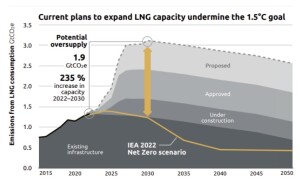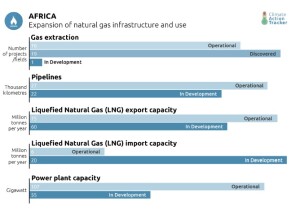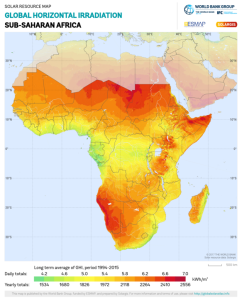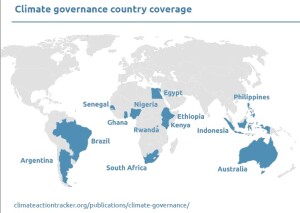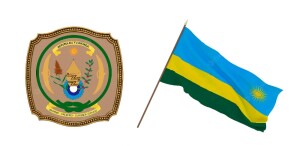Are European governments turning to African energy producers? What is the effect of Russia’s illegal invasion of Ukraine on other parts of the world? Will this threaten Africa’s transition to renewable energy? Is there any way to put the brakes on climate risk?
On December 12, 2022, the Climate Action Tracker group held a virtual event, where three experts on climate risk discussed how to accelerate the transition to renewable energy and enhance climate action in Africa, with a focus on climate governance.
Fossil gas is not the answer
To meet the 1.5°C target of the Paris Agreement, “the global demand for gas must decline,” said Hanna Fekete, a specialist at the NewClimate Institute.
She reminded the audience that under Paris-compatible pathways, no new oil and gas fields should be developed. Global gas demand should already be declining.
“The existing LNG infrastructure already exceed needs under 1.5°C scenarios,” she said. A massive expansion planned would undermine the positive climate action. LNG refers to liquefied natural gas.
Due to the Russian invasion of Ukraine, these plans are moving ahead. “The planned German LNG terminals could import 50 percent more gas than what came from Russia before the invasion,” she noted.
Fekete warns there is a huge pipeline of new gas extraction projects, pipelines, power plants and LNG facilities. Countries that have discovered gas have plans to exploit those reserves.
“Egypt is an example of benefits that can come with increased renewable energy,” she said. Renewable energy will mean higher employment and additional benefits, such as decreased air pollution and avoiding stranded assets.
Renewable Energy Transition
“How can we enable the renewable energy transition in sub-Saharan Africa?” said Deborah Ramalope, Head of Climate Policy Analysis at Climate Analytics. She said the region is currently “at a crossroads” in terms of energy development.
Quoting from a recent report by Climate Analytics, she noted that rapid growth in electricity generation is needed to overcome energy poverty and to supply power for the growing demands of industry.
The region presents a unique opportunity with a “low level of incumbent fossil fuel infrastructure” at the same time there is a large and growing demand for clean and affordable energy.
There are “abundant but underused renewable resources.” This region represents 60 percent of the world’s solar resources. Africa is famous for its sunshine.
Ramalope listed the risks of continued support of fossil fuels:
• No new gas development will be needed in a 1.5C-compatible world
• Countries risk locking in high emissions, stranded assets
• Countries will lose out on an economic opportunity to invest in renewable energy
• They will incur debt and expensive fossil fuel infrastructure
• They will increase dependency on international aid
Climate Governance Is Crucial
Claire Stockwell, Senior Climate Policy Analyst at Climate Analytics, spoke next on the importance of climate governance in delivering on targets. She showed a map of countries with climate governance regulations upcoming.
The assessment framework looks at four categories: political commitment, institutional framework, policy processes, and stakeholder engagement.
For each category, the Climate Action Tracker drilled down, the report explains. For example, was the category of “political commitment” at the government level? Or just non-governmental groups that were lobbying for change? For the category of “institutional framework,” did the country have adequate resources and effective coordination?
Stockwell said the tracker zeroes in on the policy processes because these are the core of the Paris agreement.
For example, the Climate Action Tracker posed the question: “Is there climate mitigation legislation in place, and what authority does it possess?” and then ranked the answers.
Climate Action Tracker & Governance
What is the Climate Action Tracker’s take on climate governance in a sampling of African nations? Koffi Koumassi, Implementation Specialist at Climate Analytics, reported on the nationally determined contributions (NDCs) of six nations, beginning with Rwanda. The NDCs are at the core of the Paris Agreement and they reflect the efforts of each country to reduce national emissions and adapt to the impacts of climate change.
He looked at four categories: political commitment, institutional framework, policy processes, and stakeholder engagement. Each country was given a green / yellow / orange / red designation for each criterion within each category. The countries with good climate-aware governance were Rwanda (12 million) and South Africa (60 million).
At the top of the pack, Rwanda has exemplary political commitment, but needs to “establish an inter-ministerial coordination mechanism with a clear mandate … to enhance coordination between levels of governments.”
Koumassi noted, “Rwanda must adopt a climate change law to enshrine the country’s NDC targets and 2050 net-zero CO2 emissions goals into law.”
Other countries that were coded with yellow, orange, and sometimes red were: Senegal (17 million), Nigeria (225), Ghana (32), and Kenya (56).
After the slide presentations, the four speakers responded during a Q & A session. ♠️
Click here to view the recording of the webinar, “Climate Action in Africa.”
Sources for figures in posting:
Solar power in Africa graphic is from Wikipedia. By © The World Bank, Source: Global Solar Atlas 2.0, Solar resource data: Solargis, CC BY 4.0
The Rwandan symbols are from the Freepik.com website.
All other figures are from the webinar; permission is pending.


